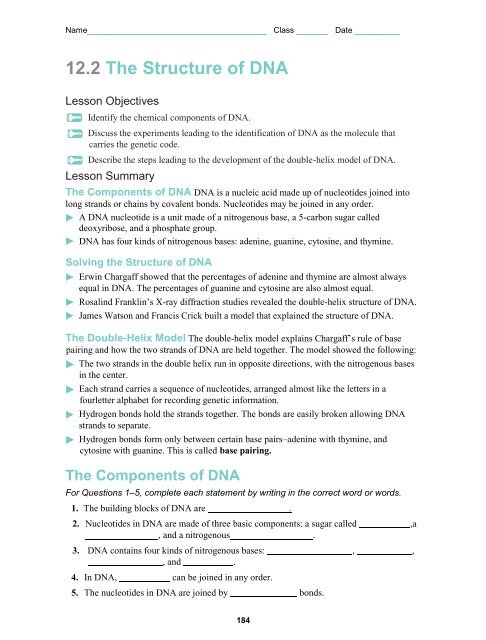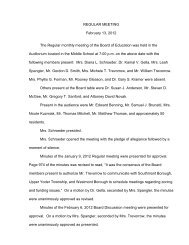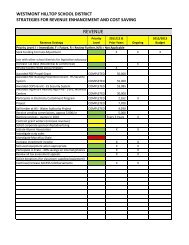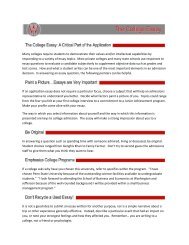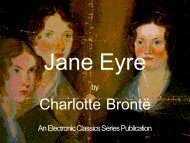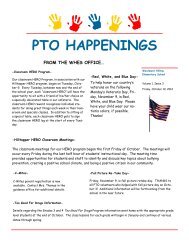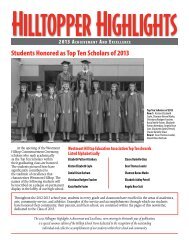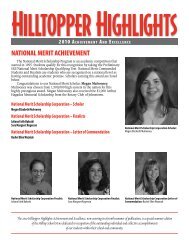12.2 The Structure of DNA - SRHSbio
12.2 The Structure of DNA - SRHSbio
12.2 The Structure of DNA - SRHSbio
You also want an ePaper? Increase the reach of your titles
YUMPU automatically turns print PDFs into web optimized ePapers that Google loves.
Name Class Date<strong>12.2</strong> <strong>The</strong> <strong>Structure</strong> <strong>of</strong> <strong>DNA</strong>Lesson ObjectivesIdentify the chemical components <strong>of</strong> <strong>DNA</strong>.Discuss the experiments leading to the identification <strong>of</strong> <strong>DNA</strong> as the molecule thatcarries the genetic code.Describe the steps leading to the development <strong>of</strong> the double-helix model <strong>of</strong> <strong>DNA</strong>.Lesson Summary<strong>The</strong> Components <strong>of</strong> <strong>DNA</strong> <strong>DNA</strong> is a nucleic acid made up <strong>of</strong> nucleotides joined intolong strands or chains by covalent bonds. Nucleotides may be joined in any order.A <strong>DNA</strong> nucleotide is a unit made <strong>of</strong> a nitrogenous base, a 5-carbon sugar calleddeoxyribose, and a phosphate group.<strong>DNA</strong> has four kinds <strong>of</strong> nitrogenous bases: adenine, guanine, cytosine, and thymine.Solving the <strong>Structure</strong> <strong>of</strong> <strong>DNA</strong>Erwin Chargaff showed that the percentages <strong>of</strong> adenine and thymine are almost alwaysequal in <strong>DNA</strong>. <strong>The</strong> percentages <strong>of</strong> guanine and cytosine are also almost equal.Rosalind Franklin’s X-ray diffraction studies revealed the double-helix structure <strong>of</strong> <strong>DNA</strong>.James Watson and Francis Crick built a model that explained the structure <strong>of</strong> <strong>DNA</strong>.<strong>The</strong> Double-Helix Model <strong>The</strong> double-helix model explains Chargaff’s rule <strong>of</strong> basepairing and how the two strands <strong>of</strong> <strong>DNA</strong> are held together. <strong>The</strong> model showed the following:<strong>The</strong> two strands in the double helix run in opposite directions, with the nitrogenous basesin the center.Each strand carries a sequence <strong>of</strong> nucleotides, arranged almost like the letters in afourletter alphabet for recording genetic information.Hydrogen bonds hold the strands together. <strong>The</strong> bonds are easily broken allowing <strong>DNA</strong>strands to separate.Hydrogen bonds form only between certain base pairs–adenine with thymine, andcytosine with guanine. This is called base pairing.<strong>The</strong> Components <strong>of</strong> <strong>DNA</strong>For Questions 1–5, complete each statement by writing in the correct word or words.1. <strong>The</strong> building blocks <strong>of</strong> <strong>DNA</strong> are .2. Nucleotides in <strong>DNA</strong> are made <strong>of</strong> three basic components: a sugar called ,a, and a nitrogenous .3. <strong>DNA</strong> contains four kinds <strong>of</strong> nitrogenous bases: , ,, and .4. In <strong>DNA</strong>, can be joined in any order.5. <strong>The</strong> nucleotides in <strong>DNA</strong> are joined by bonds.184
Name Class DateSolving the <strong>Structure</strong> <strong>of</strong> <strong>DNA</strong>6. Complete the table to describe each scientist’s contribution to solving the structure <strong>of</strong><strong>DNA</strong>.ScientistErwin ChargaffContributionRosalind FranklinJames Watson and FrancisCrick7. Complete the table by estimating the percentages <strong>of</strong> each based on Chargaff’s rules.<strong>DNA</strong> samplePercent <strong>of</strong>adeninePercent <strong>of</strong>thyminePercent <strong>of</strong>guaninePercent <strong>of</strong>cytosine1 31.52 30 203 17<strong>The</strong> Double-Helix ModelFor Questions 8–13, on the lines provided, label the parts <strong>of</strong> the <strong>DNA</strong> molecule thatcorrespond to the numbers in the diagram.185
Name Class Date14. <strong>The</strong> drawing below shows half <strong>of</strong> a <strong>DNA</strong> molecule. Fill in theappropriate letters for the other half. Explain why you drew your sketch the way you did.Apply the Big idea15. Complete this table to show how the structure <strong>of</strong> the <strong>DNA</strong> molecule allows it to performeach essential function.Function<strong>Structure</strong> <strong>of</strong> the MoleculeStore informationCopy informationTransmit information186


